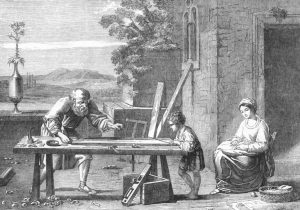Browse our full range of sash weights, balances, pulleys and hardware.
It translates as `wind eye’ the penalty obviously for anyone peering too long through those draughty slits.
Almost 1,000 years later, vindauga had evolved into ‘window’ and arrow slits into the classic sash window – a weatherproof yet straightforward closure offering the perfect balance between illumination and ventilation and for which Mighton Products today specialises in providing a comprehensive range of sash window ironmongery.
 Master Joiner – Thomas Kinward
Master Joiner – Thomas KinwardBut for the skills of London-based master joiner Thomas Kinward, it might have taken longer for the development of the box-framed sash window. In 1669 or thereabouts, he was working in the Royal apartments at Whitehall Palace.
His employer, Sir Christopher Wren asked him to put ‘a line and pulley to the window in ye Queen’s Stoole room’. It was the earliest recorded specification of a fully developed sash window. Whether Kinward thought up the characteristic counter-balancing feature or whether it was Wren himself, is undecided.
But for two centuries, the sash window reigned supreme.
By the time Anne was crowned in 1702, the traditional but inconvenient English casement window with leaded lights had all but been abandoned in favour of the sash that became the hallmark of Georgian architecture. Early versions of the sash’s classic arrangement of two lights independently held in a box frame, were single hung; the upper light was fixed, only the lower light was able to slide in the frame. By the mid 18th Century double-hung sashes were supreme. Counterbalancing was the hallmark of the era but although `sash’ derives from the French word `chassis’, the French hadn’t figured out the counter-balancing innovation and held the lower sash in place with a swivel block.
Each light had its own cord and counter-balance weight or ‘mouse’ running within the hollow frame of the whole window. Each light could slide independently within the frame yet remain in an open position without props, pegs or wedges. The early sashes held their small and expensive panes of glass with thick glazing bars. Developments in the manufacture of Crown Glass brought larger panes cut from large glass discs, sometimes up to 3ft in diameter. The thick centre, where the blower’s rod was attached and which today is mimicked by the bull’s eye panes, was discarded or sold cheaply for use at the back of the house. With larger panes, glazing bars became thinner, more intricately moulded and the classic six-over-six pane design became the norm.
The Victorian passion for things medieval revived gothic architecture and ostentatious buildings. Mass production made ornamentation cheap and builders added pattern book styles without hesitation. Sash windows became highly decorated with leaded lights, latticework and ornate stone and wood tracery.
The Victorians played the field with four, eight or twelve-pane sashes. The finest would have been 16-pane double-hung sashes that lent themselves to the larger window openings and bay fronts. More than any other component, the size, shape and number of windows created the essential style and rhythm of these buildings – both inside and out. Vertically- proportioned sash windows provided comfortable natural lighting conditions and avoided excessive glare. Careful graduation in window size from a street level not only intensified the effect of perspective but allowed more light into the more important rooms on lower floors.
Today at Mighton Products we see windows as relevant to the personality of a workman’s terrace or the shopkeeper’s villa as to the cleric’s manse and the gentry’s hall. However, the doors and windows that created this architectural impact and historic character are threatened. Conservationists fear the legacy developed by the proportions, detailing, and materials of windows and doors are being lost by the insensitive replacement with modern designs.
The offenders? Misinformation, financial incentives to modernise old houses and door-to-door sales campaigns by home `improvement’ companies.
On this Website, we give details of the extensive range of sash window hardware developed by Mighton Products for timber sash window requirements leading into the 21st century. It includes both new and renovation work. Information is also given on the special Mighton services to give customers speedy access to product information, current prices and simplified ordering systems. For more information, email us at [email protected].


Our friendly support team is happy to help.
View our knowledge hub for calculators, installations, data sheets, videos & guides.
Download our catalogues or order a paper copy delivered to your door.
Manage your cash flow with 30 days free credit & flexible credit limits.

